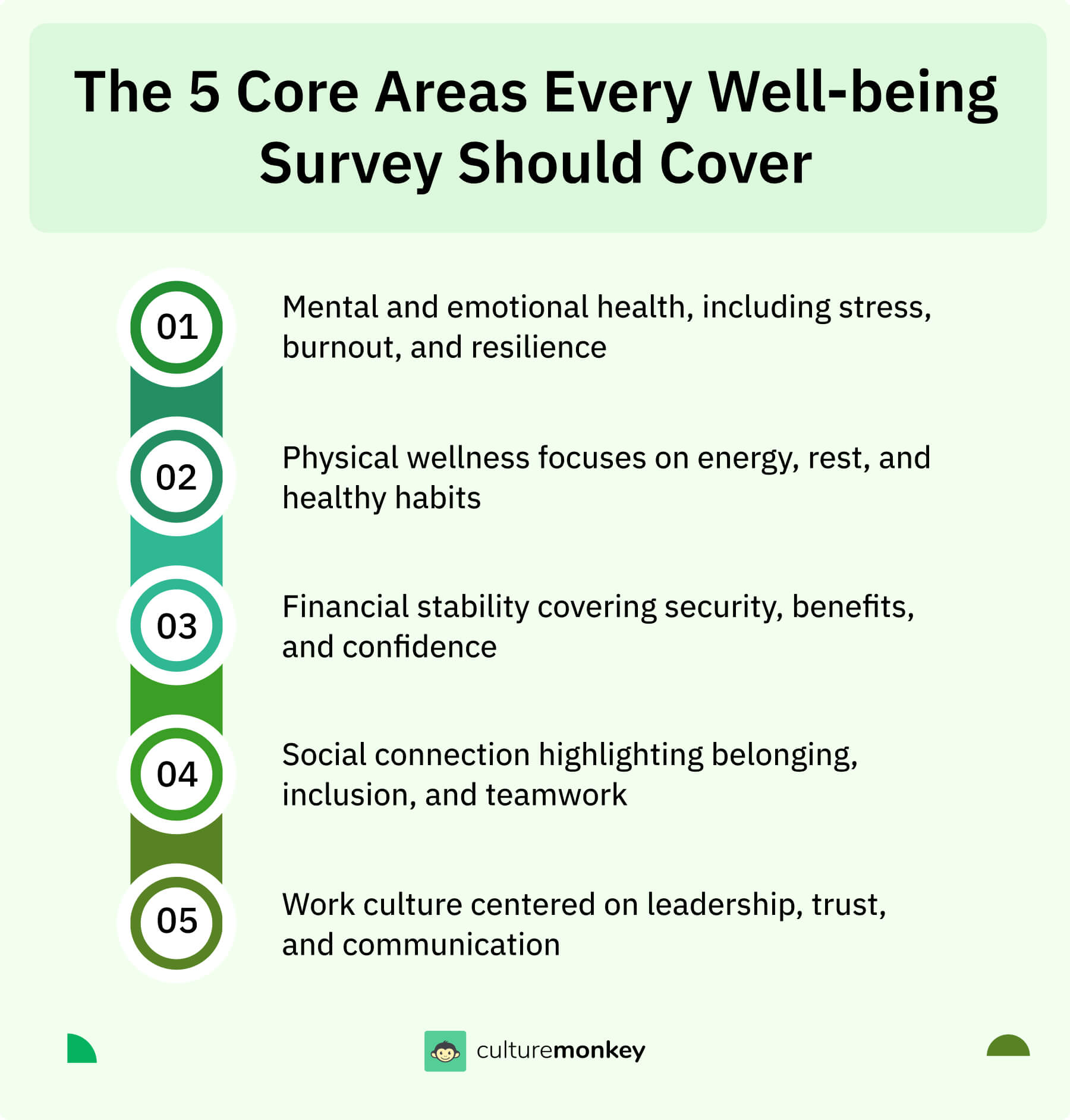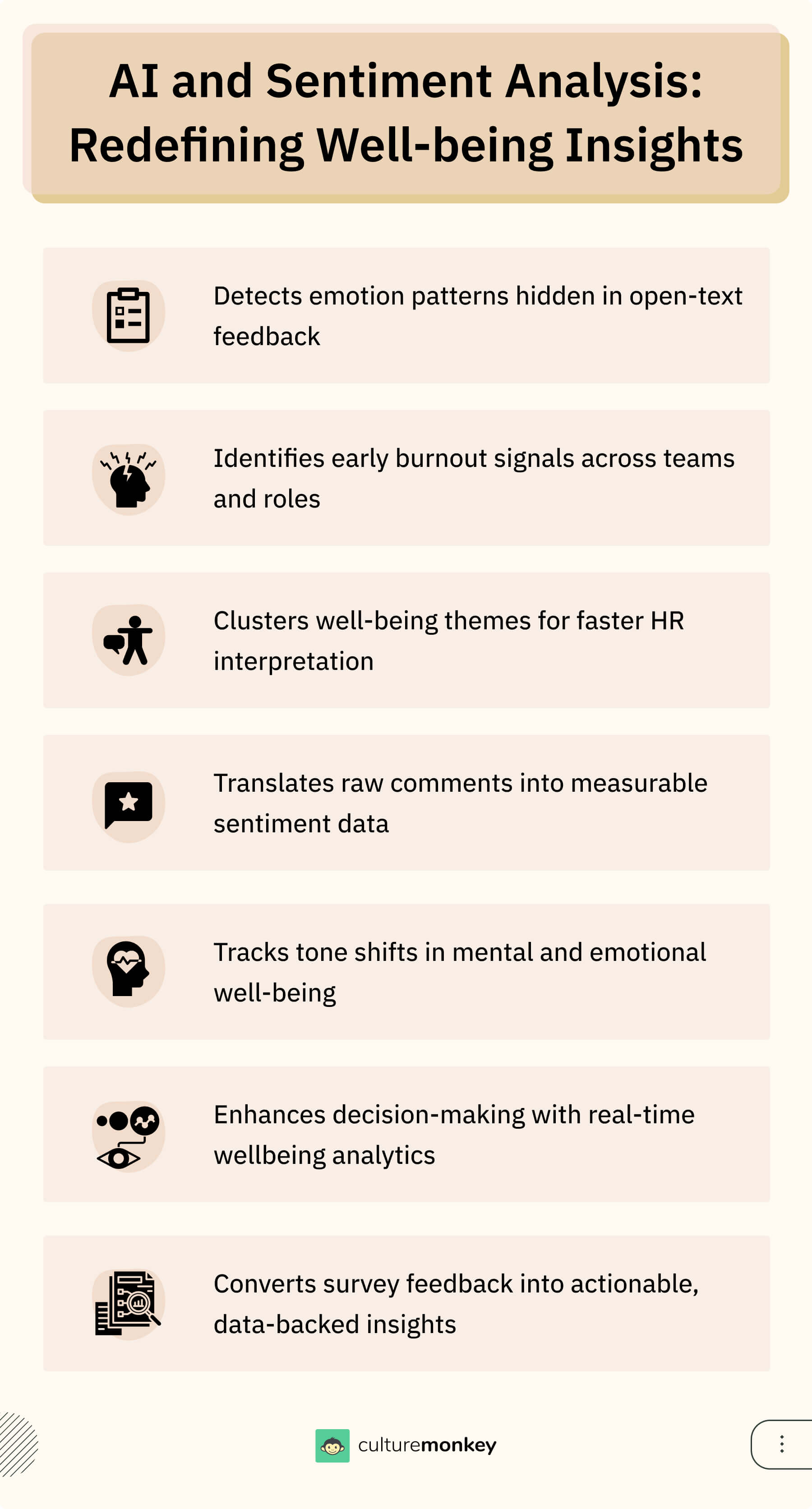70+ Well-being survey questions to uncover what your employees really feel in 2026

Remember those days when you’d ask a friend if they’d eaten, and they’d say “yeah,” even though you both knew that meant coffee and vibes? People often hide what they really need behind easy answers, not out of dishonesty, but out of habit.
Wellbeing at work is no different. Ask, “How are you?” and you’ll likely get a polite “good.” But ask the right wellbeing survey questions, and suddenly, you uncover the stories behind those smiles, the burnout, the quiet wins, the unseen stress. Because real wellbeing starts when you move past the surface and listen between the lines.
- Wellbeing surveys uncover emotional, physical, financial, and social pressures that surface-level check-ins miss.
- Clear, well-timed wellbeing questions reveal early burnout signs and help leaders act before issues escalate.
- HR teams turn wellbeing data into targeted policies, better benefits, and healthier work-life boundaries.
- AI and sentiment analysis decode tone and patterns in open-text feedback to reveal deeper workplace truths.
- Strong survey strategy, clarity, anonymity, cadence, and follow-ups, builds trust and improves overall organisational wellbeing.
Why are wellbeing surveys important in today’s workplace?

Running a workplace wellbeing survey is like switching from blurry to HD before making tough calls. You spot strain early, act faster, and avoid costly misfires. The WHO says depression and anxiety cost over $1 trillion in lost productivity each year, proof that smart wellbeing questions beat guesswork and unlock practical fixes.
- Early burnout indicator: Use a mental wellness questionnaire and regular mental health check in questions to flag fatigue, cynicism, and workload spikes early. Trend scores monthly, then coach managers to rebalance work and enable recovery before performance and retention dip.
- Evidence over opinions: Replace gut feel with employee survey questions tied to clear actions. Wellbeing questions reveal patterns, sleep, stressors, support, so leaders target fixes, not perks, and track whether changes move the needle in work-life integration and social connections.
- Comparable, repeatable insights: A workplace wellbeing questionnaire (WWQ) standardizes wording and scales, so results compare across time, teams, and locations. That lets HR see where to double down, which pilots work, and when to sunset programs that don’t shift outcomes.
- Lower friction, higher response: Share a concise wellbeing questionnaire template and a wellbeing survey questions pdf. Add guidance on how to ask wellbeing survey questions, cadence, and anonymity. Clear instructions reduce hesitation, improve completion rates, and surface honest, decision-ready data.
- Manager enablement, not guesswork: Give leaders practical scripts and mental health check in questions for one-on-ones. When check-ins mirror the survey, conversations stay consistent, problems surface earlier, and small adjustments outpace costly, late fixes to teams and schedules.
- Spot equity gaps fast: Cross-tab results by role, tenure, shift, and location to see who lacks support. If social connections or access to employee benefits score low for specific groups, redirect budget and design targeted interventions that close the gap.
- Remote truth, not assumptions: Sample wellbeing survey questions for remote employees surface isolation, tool friction, and time-zone strain. Use findings to tweak norms, response windows, meeting hours, async handoffs, so hybrid work feels fair and sustainable, not like a second-class experience.
- Make honesty easier: Mix rating scales with a few fun wellbeing questions to soften tone and boost candor. Light prompts increase completion, while open-text captures nuance algorithms miss, improving sentiment analysis and your next wellness survey iteration cadence.
- Close the loop with programs: Tie the health & wellness survey questions directly to a well-being program roadmap. When employees see benefits, schedules, and policies change quickly, trust rises and future response rates climb instead of fading after one cycle.
- Adapt for different groups: Extend your workplace wellbeing survey to interns or early-career cohorts using wellbeing survey questions for students. Tailored language keeps questions relatable, preserves data quality, and reveals support gaps in onboarding, mentoring, and growth pathways.
- Scale what works: Create a living bank of wellbeing survey questions and answers, plus survey questions examples for common scenarios. Reuse proven items, retire weak ones, and keep a clear audit trail so insights stay cumulative, not one-off.
- From pulse to policy: Use short wellness check questions in quarterly pulses, then validate shifts in an annual corporate wellness survey. This rhythm balances speed with depth and turns a wellness questionnaire for employees into a reliable operating system.
Once you’re convinced a workplace wellbeing questionnaire matters, the next step is knowing what to ask. Let’s break down essential wellbeing assessment questions every staff wellbeing survey should cover before you launch your next wellness survey for employees.
What key areas should an employee wellbeing survey cover?

Designing wellbeing surveys is like running regular health checks on your culture instead of waiting for emergencies. The right wellbeing questions reveal strain, motivation, and support levels, then turn quiet stress into visible signals. That’s why every employee wellness survey must cover a few non-negotiable areas before you hit send.
- Mental and emotional health: Use mental health and wellbeing survey questions to track stress, mood, and coping. Ask how often people feel overwhelmed, supported, or anxious, then link signals to employee wellness survey questions leaders can act on quickly.
- Physical health and energy: Include health and wellness survey questions on sleep, energy, and movement. These wellness questions highlight when workloads or environments drain people’s bodies, guiding better breaks, ergonomics, and wellbeing questions around daily physical strain and recovery.
- Work-life balance and workload: Use wellbeing survey questions for employees to explore pace, boundaries, and downtime. Well-phrased staff wellbeing survey questions uncover where overtime, meetings, or role confusion quietly erode rest, focus, and sustainable performance across teams and locations.
- Relationships, inclusion, and belonging: Add health and wellbeing questions about team support, fairness, and psychological safety. Strong employee wellness survey examples ask whether people feel heard, respected, and connected, revealing friction points that damage trust, collaboration, and day-to-day wellbeing.
- Support, benefits, and resources: Use targeted employee wellness survey questions to understand access to benefits, flexibility, and tools. Ask whether policies, managers, and programs make wellbeing easier, or leave people solving mental, physical, and financial challenges alone after hours.
- Growth, purpose, and voice: Shape staff wellbeing survey questions around learning, recognition, and influence. Well-designed wellbeing survey questions for employees reveal whether people see a future, feel proud of their work, and believe leadership listens when they speak up.
Knowing the key areas is one thing; choosing individual items is another. Now we’ll turn those pillars into an employee wellness questionnaire, showing how to pick clear wellbeing feedback questions that fit your goals and don’t overload people.

Craft Well-being Surveys, Powered by People Science
- Ready-to-use templates
- White Glove Onboarding
- Enterprise Grade Security
- Multilingual surveys
Knowing what to measure is crucial, but understanding how to ask the right questions is what turns data into real insight.
How to choose the right wellbeing survey question?
Choosing the right wellbeing survey question is like packing a carry-on: limited space forces smart choices. Start with a destination, what decision you’ll make, and pick items that fit. With a workplace wellbeing questionnaire, the right wording unlocks honest feedback, clearer trends, and faster action across mental, physical, and social wellbeing. Ask about the past week when needed.
- Start with the decision: Pick questions that drive a decision. Use a wellbeing questionnaire template to map items to actions: scheduling, benefits, manager coaching. Favor clear language, past week recall, and one idea per prompt to reduce bias and improve employee wellness quality.
- Measure one thing: Target one dimension per item. Separate mental well being, emotional well being, and physical activity to avoid double-barreled prompts. Replace vague words with examples, sleep, focus, energy, so employees answer clearly and you capture cleaner signals for trend analysis and real change.
- Match scale to decision: Match scale to the decision. In a workplace wellbeing questionnaire (WWQ), use 5-point frequency for behavior, 0–10 for intensity, and yes/no for eligibility. Keep labels clear. Calibrate employee survey questions with examples to minimize guesswork and improve reliability across teams.
(Source: McKinsey)
- Design for action: Design prompts that tell you what to do next. Practice how to ask wellbeing survey questions that invite honest feedback, rating plus text. Offer multiple ways to answer, including optional comments, to capture context and deeper insights for follow-up conversations.
- Adapt to context: Adapt wording to context. Use sample wellbeing survey questions for remote employees to capture time-zone strain, tools, and loneliness; adjust for interns or students. Consider past week framing for recall, and provide translations to keep responses inclusive and comparable.
- Pilot, then refine: Pilot questions with a small group. Flag confusing items, low-variance scales, and missing options. Keep a library of best wellbeing questions for HR, retire weak ones, and version changes so trend lines remain comparable as the questionnaire improves over time.
Once you understand how to shape questions, the next step is practical examples. Let’s explore ready-made wellbeing pulse survey items, employee mental wellbeing survey prompts, and wellbeing index questions you can plug into your next workplace wellness assessment.
70+ Wellbeing survey questions to ask your team in 2026

Crafting the right wellbeing survey questions is what turns feedback into meaningful action. Employee wellness surveys differ from a traditional engagement survey, as they focus specifically on health and well-being rather than overall job satisfaction and organizational engagement.
While an engagement survey is typically conducted annually and provides a comprehensive assessment of employee engagement, employee wellness surveys are designed to regularly assess and improve employee well-being.
Overall wellbeing survey questions for employees
Overall wellbeing survey questions for employees
(8 questions)
These questions form the foundation of any well-being questionnaire template, helping you assess overall satisfaction, energy, and emotional stability.
-
1
How would you rate your overall sense of well-being at work?
(Poor → Excellent)
-
2
Do you feel supported by your employer in maintaining physical and mental wellness?
(Not at all supported → Fully supported)
-
3
How often do you feel genuinely motivated and energized throughout the workweek?
(Almost never → Almost always)
-
4
Does your workload allow you to maintain work-life integration without burnout?
(Never manageable → Always manageable)
-
5
How confident are you that leadership prioritizes employee wellbeing?
(Not confident at all → Extremely confident)
-
6
How frequently do you experience stress that impacts your productivity?
(Very frequently → Never)
-
7
Do you believe your current role supports your long-term well-being goals?
(Strongly disagree → Strongly agree)
-
8
How would you rate your overall workplace wellbeing?
(Extremely low → Exceptionally high)
Work-life balance and wellness survey questions
Work-life balance and wellness survey questions
(8 questions)
These employee wellness survey questions explore how effectively your organization supports personal time and flexibility.
-
1
Do you feel you can disconnect from work during your personal time?
(Rarely able to disconnect → Always able to disconnect)
-
2
Are you encouraged to take time off or wellness breaks without guilt?
(Never encouraged → Always encouraged)
-
3
How manageable is your current workload on a weekly basis?
(Not manageable at all → Very manageable)
-
4
Do you feel supported in maintaining a healthy balance between work and life?
(Not supported at all → Fully supported)
-
5
How often does work spill into your personal or family responsibilities?
(Very frequently → Never)
-
6
Do you believe your manager respects personal boundaries?
(Strongly disagree → Strongly agree)
-
7
How easy is it to manage caregiving, health, or family duties alongside work?
(Very difficult → Very easy)
-
8
Do you have flexibility in your schedule to support overall wellbeing?
(No flexibility → Full flexibility)
Physical and social wellbeing questions
Physical and social wellbeing questions (8 questions)
This section blends health & wellness survey questions with physical, mental, and social wellbeing indicators to give a complete view.
-
1
How would you describe your daily energy levels during work hours?
(Very low → Very high)
-
2
Are you able to take breaks for physical movement or relaxation?
(Rarely able to → Always able to)
-
3
Do you feel your workspace supports ergonomic comfort and physical health?
(Not at all supportive → Fully supportive)
-
4
How encouraged are you to maintain healthy lifestyle habits like exercise or proper rest?
(Not encouraged at all → Highly encouraged)
-
5
Do you experience fatigue or physical strain due to work conditions?
(Very frequently → Never)
-
6
How connected do you feel to your colleagues socially during a typical week?
(Not connected at all → Very connected)
-
7
Do you feel you can express personal challenges openly without judgment?
(Strongly disagree → Strongly agree)
-
8
How satisfied are you with the company’s focus on holistic health and wellness?
(Very dissatisfied → Very satisfied)
Employee mental health and wellness questionnaire
Employee mental health and wellness questionnaire
(8 questions)
Use these mental wellbeing survey questions to assess emotional resilience, stress levels, and access to mental health support.
-
1
How often do you feel mentally drained or emotionally exhausted by work?
(Very frequently → Never)
-
2
Do you feel comfortable sharing mental health concerns with your manager or HR?
(Not comfortable at all → Very comfortable)
-
3
How supported do you feel by company programs promoting psychological safety?
(Not supported at all → Fully supported)
-
4
How effective are mental health resources or EAP services provided by the organization?
(Not effective at all → Very effective)
-
5
Do you believe your workplace encourages open conversations about mental wellness?
(Strongly disagree → Strongly agree)
-
6
How confident are you in taking a mental health day without stigma?
(Not confident at all → Extremely confident)
-
7
Have you noticed early signs of burnout or emotional fatigue recently?
(Very frequently → Not at all)
-
8
How can leadership make mental health check-ins more approachable?
(Not approachable at all → Very approachable)
Financial wellbeing survey questions
Financial wellbeing survey questions (8 questions)
These questions gauge how corporate wellness surveys and financial policies support employee security.
-
1
Do you feel fairly compensated for your role and contributions?
(Strongly disagree → Strongly agree)
-
2
How confident are you in your financial stability over the next 12 months?
(Not confident at all → Extremely confident)
-
3
Do financial worries affect your concentration or motivation at work?
(Very frequently → Never)
-
4
Are you aware of financial wellness resources or programs offered by the company?
(Not aware at all → Fully aware)
-
5
Do you believe compensation policies are transparent and equitable?
(Strongly disagree → Strongly agree)
-
6
Are there financial benefits or perks you’d like to see added (e.g., insurance, retirement)?
(Not at all → Definitely yes)
-
7
How effectively does your company address employee financial stress?
(Not effectively at all → Very effectively)
-
8
Would financial literacy sessions or support improve your wellbeing?
(Not at all → Definitely yes)
Social connections and inclusion wellbeing questions
Social connections and inclusion wellbeing questions
(8 questions)
These workplace wellbeing questionnaires (WWQ) prompts assessment of belonging, teamwork, and psychological safety.
-
1
Do you feel connected to your colleagues on a daily basis?
(Not connected at all → Very connected)
-
2
How inclusive do you feel the company’s culture and policies are?
(Not inclusive at all → Highly inclusive)
-
3
Do you have someone at work you can rely on for honest conversations?
(Strongly disagree → Strongly agree)
-
4
How often do you feel isolated in your role or team?
(Very frequently → Never)
-
5
Do you feel your background and identity are valued and respected?
(Strongly disagree → Strongly agree)
-
6
How well does your company encourage collaboration and social bonding?
(Not well at all → Extremely well)
-
7
Do you feel recognized for your contributions within the team?
(Rarely recognized → Always recognized)
-
8
What more could be done to strengthen inclusion and belonging?
(Not much needed → Significant improvement needed)
Work culture and engagement survey questions
Work culture and engagement survey questions
(8 questions)
These employee engagement survey questions explore leadership trust, recognition, and purpose alignment.
-
1
How inspired do you feel by the company’s mission and goals?
(Not inspired at all → Highly inspired)
-
2
Do you trust leadership to act in the best interest of employees?
(Do not trust at all → Fully trust)
-
3
Do you feel your feedback influences organizational decisions?
(Strongly disagree → Strongly agree)
-
4
How satisfied are you with communication across teams?
(Very dissatisfied → Very satisfied)
-
5
Do you feel recognized and appreciated for your contributions?
(Rarely recognized → Always recognized)
-
6
Does the company promote fairness and mutual respect?
(Strongly disagree → Strongly agree)
-
7
How likely are you to recommend your company as a great place to work?
(Very unlikely → Very likely)
-
8
How engaged do you feel during daily work activities?
(Not engaged at all → Highly engaged)
Employee benefits and wellbeing program survey questions
Employee benefits and wellbeing program survey questions (8 questions)
These health and wellness survey questions for employees explore satisfaction with benefits and support programs.
-
1
How satisfied are you with your current healthcare and insurance options?
(Very dissatisfied → Very satisfied)
-
2
Do wellness programs meet your physical and mental health needs?
(Not at all → Completely)
-
3
Are you aware of all wellbeing initiatives available to you?
(Not aware at all → Fully aware)
-
4
Do you believe the benefits offered align with your personal wellbeing goals?
(Strongly disagree → Strongly agree)
-
5
How effective are employee perks in reducing stress and improving balance?
(Not effective at all → Very effective)
-
6
Are there benefits missing that could improve your quality of work life?
(None missing → Many missing)
-
7
Do you feel employee wellness programs are inclusive and accessible?
(Strongly disagree → Strongly agree)
-
8
How can HR improve wellbeing offerings in future wellness surveys?
(No improvement needed → Significant improvement needed)
Workplace climate and safety wellbeing survey questions
Workplace climate and safety wellbeing survey questions
(8 questions)
These staff wellness survey items evaluate safety, fairness, and transparency.
-
1
Do you feel physically and emotionally safe in your workplace?
(Not safe at all → Completely safe)
-
2
How transparent is communication from leadership regarding decisions?
(Not transparent at all → Fully transparent)
-
3
Do you feel workplace conflicts are resolved fairly and promptly?
(Strongly disagree → Strongly agree)
-
4
How comfortable are you raising sensitive concerns or feedback?
(Not comfortable at all → Very comfortable)
-
5
Does the current workplace climate encourage collaboration and trust?
(Strongly disagree → Strongly agree)
-
6
Do you believe leadership acts quickly on employee feedback?
(Never → Always)
-
7
How often do you feel tension or stress due to team dynamics?
(Very frequently → Never)
-
8
How would you describe the overall atmosphere in your workplace?
(Negative and stressful → Positive and supportive)
Remote or hybrid employee wellbeing survey questions
Remote or hybrid employee wellbeing survey questions
(8 questions)
These sample wellbeing survey questions for remote or hybrid employees focus on connection, access, and balance.
-
1
Do you feel equally included whether you work remotely or in-office?
(Not included at all → Fully included)
-
2
How supported do you feel when working from home or in hybrid mode?
(Not supported at all → Fully supported)
-
3
How well do digital tools support collaboration and social interaction?
(Not well at all → Extremely well)
-
4
Do you experience loneliness or isolation while working remotely?
(Very frequently → Never)
-
5
Are you satisfied with the flexibility your work model provides?
(Very dissatisfied → Very satisfied)
-
6
Do you have equal career growth opportunities regardless of location?
(Strongly disagree → Strongly agree)
-
7
How can the company better support remote employee wellbeing?
(No improvement needed → Significant improvement needed)
-
8
What changes would make hybrid work healthier and more engaging?
(No changes needed → Major changes needed)

Access the ultimate guide to
15 well-being survey questions
Download now
Having a long list of wellbeing questions is helpful, but without a plan they’re just text on a screen. Next, we’ll turn them into a coherent organisational wellbeing survey strategy and wellness survey for employees people actually complete.
Tips for creating your employee well-being survey strategy
A strong well-being survey strategy is clear, concise, and consistent. Define goals, keep questions short, mix formats, and communicate purpose openly.
Regular pulse checks and follow-ups turn feedback into measurable action that strengthens trust, engagement, and organizational wellbeing over time.
Designing a survey is more than pulling together a few staff survey questions. To truly uncover insights, your approach needs to be structured, empathetic, and intentional. Here are some practical tips to shape a strategy that gets honest and useful responses.
- Start with clear objectives: Decide upfront what you want to learn—whether it’s stress levels, engagement, or psychological safety survey questions. Clear goals will help you frame better questions and avoid a vague wellness questionnaire for employees that lacks focus.
- Keep the survey short and relevant: A survey that drags on will lead to drop-offs. Instead, prioritize meaningful wellbeing survey questions for employees and make sure every item links back to your goals. Quality beats quantity here.
- Use a mix of question types: Combine rating scales, multiple-choice, and open-ended prompts. This helps balance structured employee wellness survey results with the richness of personal experiences.
- Make timing part of the strategy: Don’t wait for the annual review cycle. Send a quick wellbeing pulse check quarterly to track trends and address issues before they snowball into bigger problems.
- Incorporate follow up surveys: Use follow up surveys to track the impact of wellness initiatives over time, collect comparative data, and benchmark progress against industry standards.
- Communicate the purpose transparently: Employees are more likely to engage when they understand how the results will be used. Share how survey findings feed into HR policies, benefits, and overall workplace well-being improvements.
A smart strategy still fails if people mask how they really feel. Next, we’ll turn your staff wellbeing survey into a safe space with wording, timing, and channels that encourage braver, more candid wellbeing feedback questions.
Tips to encourage honest answers in sensitive wellbeing surveys

Getting employees to open up about their mental health, stress, or financial worries isn’t easy. If surveys feel risky or vague, responses will stay polite and surface-level. Here’s how you can create an environment where people feel safe to share openly.
- Reassure anonymity: Clearly state that responses can’t be traced back to individuals. Pair this with third-party handling of wellbeing survey questions to ease fears around sensitive disclosures.
- Use empathetic wording: The phrasing of health and wellness survey questions matters. Avoid clinical or judgment-heavy language, and instead use approachable, human-centric wording.
- Keep it short and focused: Overly long surveys cause fatigue and rushed answers. Focus only on the most important wellbeing survey questions for employees to get honest, thoughtful input.
- Share past actions taken: Employees will be more candid if they’ve seen their feedback lead to real change. Reference how previous employee wellness survey results shaped new initiatives.
- Offer multiple response formats: Include open-text options alongside rating scales. This allows employees to express nuanced concerns that might not fit into a simple score, giving you a fuller view of social well-being and engagement.
Once people start answering honestly, the real work begins. In the next section, we’ll show how HR can turn workplace wellbeing questionnaire results and employee wellness questionnaire data into clear policy changes, better programs, and measurable business outcomes.
How do HR teams use wellbeing data to improve policies?
HR teams use wellbeing survey data to turn feedback into smarter policies and tangible results.
By analyzing patterns in stress, engagement, and benefits, they design targeted programs, update wellness initiatives, and train managers, creating healthier, fairer, and more productive workplaces.
Using well-being data is like upgrading from a hunch to a dashboard before you change lanes at work. A workplace wellbeing survey turns scattered feelings into signals you can act on, so policies improve faster, cleaner, and with fewer unintended consequences.
- Set clear outcomes: Start with a wellbeing questionnaire template that maps employee wellbeing survey questions to actions. Define targets for work-life integration, social connections, and overall well-being, then commit to changing processes, not perks, when scores slip across consecutive pulses.
- Segment for fairness: Break results by role, tenure, shift, and location. Use sample wellbeing survey questions for remote employees to spot isolation, and monitor an early burnout indicator. Fix conditions first, then coach managers; treat variance as a system problem, not individual weakness.
- Triangulate signals: Pair mental health check-in questions and staff feedback survey comments with behavioral data and exit themes. When wellness survey patterns align with sentiment, you’ve found a policy lever, meeting load, scheduling, or tooling, worth testing immediately at team scale.
- Prioritize a roadmap: Translate insights into a quarterly well-being program plan. Tackle the highest-friction issues first, meeting norms, flexibility, Employee benefits, then schedule follow-ups. Small, visible wins beat sweeping promises; publish owner, timeline, and expected gain for each policy change.
- Pilot and iterate: Run controlled trials using a workplace wellbeing questionnaire. Compare pre/post-scores and retention for pilot groups. Keep what moves the needle, retire what doesn’t. Document survey questions examples to standardize future tests.
- Close the loop: Share findings in plain language with Wellbeing survey questions and answers, plus a concise wellbeing survey questions pdf. Explain how to ask wellbeing survey questions and what will change next. Transparency boosts trust, participation, and data quality in the next pulse.
- Equip managers: Provide one-on-one toolkits with wellness check questions or a mental wellness questionnaire. Teach escalation paths, boundaries, and follow-through. Consistent check-ins convert insights into daily habits that prevent issues from snowballing between survey cycles.
- Set cadence and governance: Use quarterly wellness questionnaires for employees plus an annual corporate wellness survey. Establish data owners, revalidation windows, and a sunset policy for stale metrics. Treat the workplace well-being survey as your operating system, not a yearly ritual.
Even with strong analysis, tone and nuance in a wellbeing engagement survey can be missed. Next, we’ll explore how AI and sentiment tools scan comments, wellbeing pulse survey questions, and wellbeing index questions for emotional patterns humans often overlook.
Using AI and sentiment analysis to decode wellbeing survey responses

Using AI on wellbeing feedback is like switching on subtitles in a noisy meeting. Suddenly, the quiet parts become clear. Sentiment analysis reads tone across employee survey questions and open text, turning scattered comments into patterns you can act on.
That clarity unlocks smarter follow-ups, stronger wellbeing questions, and faster fixes at scale.
- Find signals early: Use sentiment to cluster open-text from wellness check questions and mental well-being survey questions. Track an early burnout indicator across time, spikes by team, and language shifts, then trigger faster check-ins and workload resets before issues snowball.
- Read emotion, not guesses: Models score positivity, negativity, and uncertainty across employee wellbeing survey questions and physical, mental and social wellbeing questions. Pair themes with frequency, so leaders prioritize fixes with lift, not opinions or perks that miss root causes.
- Personalize by context: Compare sentiment for sample wellbeing survey questions for remote employees and segment them by tenure, shift, or location. Aim for work-life integration by addressing tool friction, time zones, or onboarding gaps in comments.
- Turn patterns into programs: Map themes to a well-being program roadmap: meeting norms, quiet hours, Employee benefits, or manager training. Use survey questions examples to measure before/after, then publish owners and timelines so changes feel visible, quick, and accountable.
- Coach better conversations: Share how to ask wellbeing survey questions, with mental health check in questions and fun wellbeing questions for tone. Provide a wellbeing survey questions PDF and one-page guides, so managers run consistent, stigma-free chats that people trust.
- Make it repeatable: Standardize a workplace wellbeing questionnaire (WWQ) and wellbeing questionnaire template to share across teams. Rotate wellness survey questions for employees quarterly, and a corporate wellness survey annually. Archive wellbeing survey questions and answers to keep learning compounding, not resetting.
Honesty thrives where trust exists and anonymity is the foundation. Here’s how to protect privacy and get usable insights.
"Do we really need wellbeing surveys? Aren’t they just a feel-good initiative?"
A common objection many leaders raise is that wellbeing surveys feel like a “feel-good initiative”, something that’s nice in theory but not essential to operations.
After all, shouldn’t organizations focus on performance and productivity rather than feelings?But according to Global Wellness Institute, companies prioritizing well-being report up to 20% higher productivity, 10% higher retention rates and reduced absenteeism.
This means that proactively measuring and addressing well-being isn’t a luxury; it’s a strategic necessity that directly affects productivity, retention, and bottom-line results.
How to keep wellbeing surveys anonymous but still actionable?

One of the biggest barriers to honest answers is fear of being identified. Employees won’t reveal their true mental, emotional, or financial struggles if they think responses can be traced back to them.
Many companies choose to work with third-party survey vendors to protect employee privacy and encourage participation. That’s where third-party survey vendors come in—helping you balance confidentiality with meaningful insights while respecting personal responsibilities.
- Use a trusted external partner: Vendors specialize in collecting staff survey questions and responses in a way that protects anonymity. Their role as a neutral party builds confidence among employees.
- Set clear anonymity thresholds: Ensure that reports only share aggregated employee wellness survey results, with a minimum number of responses before data is displayed. This prevents singling out individuals in small teams.
- Customize reporting categories: Ask your vendor to slice results by department, tenure, or role without compromising identity. That way, you still gain targeted insights without breaching trust.
- Communicate the process upfront: Tell employees exactly how their responses will be handled. Transparency about third-party safeguards reduces hesitation in answering sensitive psychological safety survey questions.
- Provide managers with action-ready summaries: Vendors can translate anonymous data into clear insights and recommendations, so leaders know what to improve without needing personal identifiers.
- Regularly audit the system: Check in with your vendor to ensure processes remain secure and compliant. Over time, this builds lasting trust, encouraging higher participation in every wellbeing pulse check.
If this all sounds complex to run manually, you’re not wrong. That’s why the next section shows how CultureMonkey simplifies organisational wellbeing survey design, automates wellness surveys for employees' workflows, and turns anonymous signals into practical playbooks.

Why is CultureMonkey your go-to tool for smarter wellbeing surveys?
Running a survey is easy—running one that sparks honesty and drives action is the real challenge. That’s where CultureMonkey steps in. It’s built to turn wellbeing survey questions into actionable insights that actually improve employee experience.
- Ready-to-use survey templates: CultureMonkey comes with curated health and wellness survey questions and psychological safety survey questions, saving HR teams hours of guesswork.
- Pulse checks made simple: Send quick wellbeing pulse checks to track changing moods without overwhelming employees. Frequent feedback means no blind spots between annual surveys.
- AI-driven sentiment analysis: The platform automatically decodes tone and emotion in open-ended feedback, giving HR a richer context beyond scores and charts.
- Actionable reports for leaders: Instead of raw data dumps, CultureMonkey delivers clear employee wellness survey results that managers can turn into policy updates.
- Support for hybrid and global teams: Built to capture input across geographies, it ensures both in-office and remote voices are equally heard in staff survey questions.
- End-to-end anonymity: By guaranteeing privacy, CultureMonkey encourages candid responses, helping employees feel safe to answer even the most sensitive wellness questionnaire for employees.

Conclusion
A workplace runs well when people feel seen, supported, and understood, and that starts with asking the right wellbeing survey questions. Thoughtfully designed emotional survey questions, health well-being survey questions, burnout survey questions, and even hybrid working survey questions reveal what employees won’t say in passing conversations.
They help leaders spot hidden stress, guide better decisions, and prevent issues long before they affect performance, morale, or retention. Community wellbeing survey questions also show how connected people feel, which is crucial in dispersed, hybrid, or shift-based teams.
CultureMonkey strengthens this process by turning raw responses into clear insights leaders can act on. Its templates, analytics, and anonymous feedback flows make it easier to collect honest input, understand patterns, and close the loop quickly.
With CultureMonkey, organisations move from guesswork to evidence-based action, building healthier teams, stronger trust, and a workplace where wellbeing becomes a shared priority, not an afterthought.
FAQs
1. How do you create a survey for mental health at work?
Design surveys that explore emotional wellbeing, mental health, and overall wellness. Include questions on stress, lifestyle habits, and physical activity over the past week. Add prompts about company support and use varied formats to encourage candid responses. This approach uncovers deeper insights into workplace culture, empowering leaders to build a healthier, more supportive environment.
2. Should well-being surveys be anonymous?
Yes. Keeping surveys anonymous helps people share honest answers without fear. When employees know their identity is protected, they are more likely to talk about stress, burnout, or support needs. Anonymous surveys reveal deeper insights into wellbeing and job satisfaction, helping you create a safer, more open, and more supportive workplace culture over time.
3. How often should we run wellbeing checks?
Running surveys monthly or every quarter helps you track how employees feel without overwhelming them. Ask short questions about their stress, health, and support from the past week. Frequent feedback helps you spot problems early, build trust, and create a workplace where people feel heard, valued, and supported before small issues grow bigger.
4. Can I ask about stress and burnout in a workplace survey?
Yes. Asking about stress, workload, and signs of burnout helps you understand how employees are coping. Questions about sleep, focus, and energy can reveal early warning signs. Addressing these issues quickly with the right support prevents bigger problems, builds trust, and creates a healthier workplace where employees feel balanced and able to perform.
5. What tools can I use to send and analyze well-being surveys?
Use employee wellness platforms that collect feedback easily and show results clearly. The best tools visualize patterns in stress, physical activity, and support levels. Dashboards help you understand trends and take action. With these insights, HR can improve policies, design better programs, and create a workplace where employees feel healthy, valued, and supported.
6. What’s the best time to send a wellbeing pulse check?
Send surveys in the middle of the week, ideally Tuesday to Thursday. People reflect more clearly on how they feel during this time. Midweek surveys give more balanced and honest answers about stress, energy, and wellbeing. This small change improves feedback quality and helps you make better decisions about workplace health and support.
7. How to know if your employees are quietly struggling?
Look for subtle changes like low energy, less participation, or withdrawal from conversations. Combine surveys with regular check-ins to understand how people feel. Honest feedback can reveal early signs of burnout or disengagement. Acting quickly builds trust, offers needed support, and creates a workplace where employees feel cared for and connected.
8. How do you have a wellbeing conversation at work?
Start with casual, open questions about sleep, habits, stress, and motivation from the past week. Listen carefully and avoid judgment. Building trust helps people share honestly. Talking openly about wellbeing shows you care and strengthens relationships. It also helps you find solutions together, improving health, satisfaction, and workplace culture for the long term.
9. How to ask wellbeing questions?
Keep questions simple and natural. Ask about sleep, motivation, and energy over the past week. Use a mix of rating scales and open-ended questions to get honest answers. Cover emotional, physical, and social wellbeing for a complete picture. Clear, relatable questions help you understand what employees need and guide meaningful workplace improvements.
10. What questions should I ask in a wellbeing survey?
Ask about stress levels, daily habits, emotional wellbeing, and how supported people feel. Include questions about work-life balance, motivation, and relationships. Cover different aspects of wellbeing to get a full picture of employee experience. These questions reveal patterns, improve engagement, and guide better decisions to support health and happiness at work.
11. What are the 5 basic questions for surveys?
These questions build a simple but powerful snapshot of overall employee wellbeing and workplace culture.
- How did you feel this week?
- Do you often feel tired or struggle to sleep?
- Does your company support your health?
- How are your relationships with coworkers?
- Do you have a close friend at work?
12. What’s the best survey solution to measure and improve employee well-being at work?
The best solution combines emotional, mental, and physical health insights in one place. It should collect feedback easily, analyze data quickly, and show clear results. A good tool helps you track trends, spot problems early, and design better support programs. This creates a stronger workplace where employees feel healthy, valued, and engaged.
13. How often should you run employee wellbeing surveys?
You should monitor wellbeing every quarter to catch changes early across mental wellness, physical wellness, work hours, and stress levels. Frequent surveys help track physical health, healthy work life balance, and the impact of wellness programs. This rhythm strengthens company culture and creates a more positive workplace where employees feel supported consistently throughout the year.
14. What’s the difference between wellness and wellbeing in surveys?
Wellbeing refers to someone’s overall emotional, mental wellness, physical health, and daily experience at work. Wellness focuses more on lifestyle habits and wellness programs that support physical wellness. In surveys, wellbeing includes connection, purpose, and company culture, while wellness tracks habits that create a positive workplace and help maintain a healthy work life balance.
15. How can we improve response rates to wellbeing surveys?
Improve response rates by keeping surveys short, sharing why they matter, and showing employees how much importance you place on mental wellness and physical wellness. Offer flexible work hours for completion, highlight how results shape wellness programs, and ensure anonymity. When employees see surveys create a more positive workplace, they respond honestly and more consistently.







